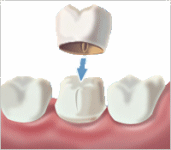
What are Dental Crowns?
A dental crown is an indirect restoration that covers the entire visible part of the tooth with a tooth-shaped “cap” in order to replace lost tooth structure, to protect and strengthen the tooth. Dental crowns, also known as caps, are fabricated to mimic the shape and size of the tooth to repair and restore or improve the aesthetics and functionality of the tooth.
Dental crowns, and especially porcelain crowns, are the most used restorative treatment for severely damaged teeth. They are also frequently used to cover dental implants or abutment teeth when fitting a bridge.
When Is a Dental Crown Needed?
Your dentist may recommend the use of dental crowns for a number of different reasons, that can be grouped in the following basic categories:
- Restoring a damaged tooth.
- Strengthening a tooth.
- Improving the cosmetic appearance of a tooth.
- Covering a dental implant or supporting a dental bridge
Dental crowns can be used if you experience any of the following conditions:
- Severe tooth decay. If a tooth has decayed the dentist has several options to restore the tooth using dental fillings, inlays or onlays, or dental crowns. However if dental cavities are so extensive that there is not adequate quantity of healthy tooth structure left and the tooth is too weakened to hold a filling or an onlay, dental crowns are usually the only option.
- Broken tooth. A tooth that has broken or fractured is usually too weakened to be treated with a simple filling. If the tooth can be saved, the dentist will use a dental crown to restore it and prevent it from breaking again.
- Cracked tooth. Teeth cracks can not be sealed with fillings. Dental crowns can keep together the cracked area, and prevent the crack from expanding under the chewing pressure. Otherwise even a small crack can widen and cause further damage leading to a broken tooth that may not be saved.
- Root canal treatment. Teeth that had root canal treatment tend to become brittle and have increased risk of breakage. Furthermore after a root canal therapy, the patient may not become aware that the tooth has decayed or cracked because there is no pain (since the nerve is removed). For these reasons, dentists usually prefer to restore a tooth after root canal treatment with a dental crown than a filling, in order to provide the best protection for the treated tooth.
- Bruxism. Teeth grinding can cause significant damage to the enamel of the chewing surfaces of teeth that is better restored with a dental crown. The best solution for bruxism patients is a crown made of metal alloy and not porcelain because it can be easily damaged by teeth grinding.
- Large old fillings. A tooth that already has a filling remains susceptible to tooth decay (even more that a tooth without a filling yet). Additional fillings reduce further the remaining healthy tooth structure increasing the risk of fracture and tooth loss. Dentists recommend to replace large old fillings that extend to more than half of the tooth with dental crowns to prevent teeth from further damage.
- Aesthetic improvement. Dental crowns are also used by cosmetic dentists in order to improve the appearance of misshaped, crooked or discolored teeth. Although the use of dental crowns for cosmetic reasons was very popular until some years ago, today cosmetic dentists prefer to use (if possible) alternative cosmetic treatments such as dental bonding or porcelain veneers that do not require the removal of as much healthy enamel as crowns.
- Dental bridges. A dental bridge consists of an artificial tooth (pontic), that is used to replace a missing tooth, fused to two dental crowns used to support the bridge. The crowns are cemented on the abutment teeth, one on each side of the missing tooth.
- Dental implants. A missing tooth can also be replaced with a dental implant which substitutes the missing tooth root. A dental crown is fitted on top of the dental implant in place of the missing tooth’s natural crown.
Types of dental crowns
Depending on the type of material used, dental crowns can be classified in the following types:
- All porcelain dental crowns. They are made of porcelain, ceramic or glasslike materials that due to their color and translucency look much closer to the natural teeth than any other type of dental crowns. They are the best choice for front teeth.
- Porcelain fused to metal dental crowns (PFM). They are composed of a porcelain crown bonded to a metal base, made of gold or other metal alloy. Porcelain fused to metal crowns are stronger and more durable than all porcelain ones but they do not provide the same cosmetic results.
- Gold crowns. Gold crowns are the most traditional type. They provide the highest durability, strength and resistance to wear but they are not as popular due to aesthetic reasons. Dentists prefer to use gold crowns mostly for back teeth (such as molars).
The Dental Crown Procedure
Typically, the dental crown procedure is completed in two stages. During the first stage, the dentist removes part of the natural tooth’s structure from the chewing surface and all sides of the tooth to make room for the placement of the dental crown. Then an impression of the prepared and the surrounding teeth is taken and send to the dental lab. A temporary crown is placed to protect the tooth until the final crown is fabricated by the lab. When it is ready, the patient returns for the second stage of treatment. The temporary crown is removed and the final dental crown is cemented permanently on the tooth.

